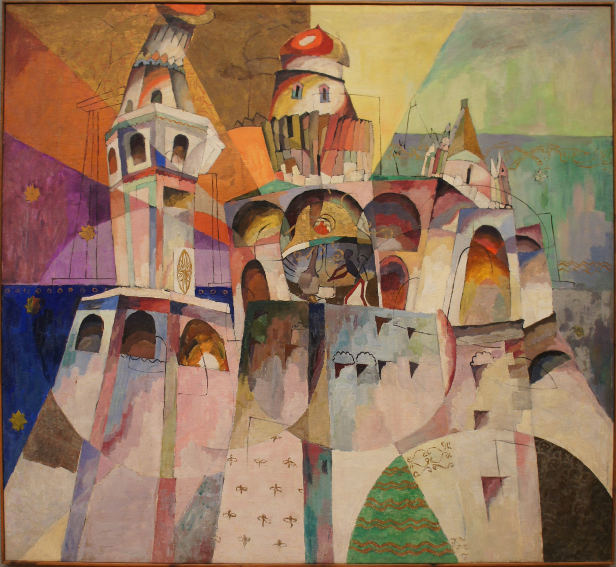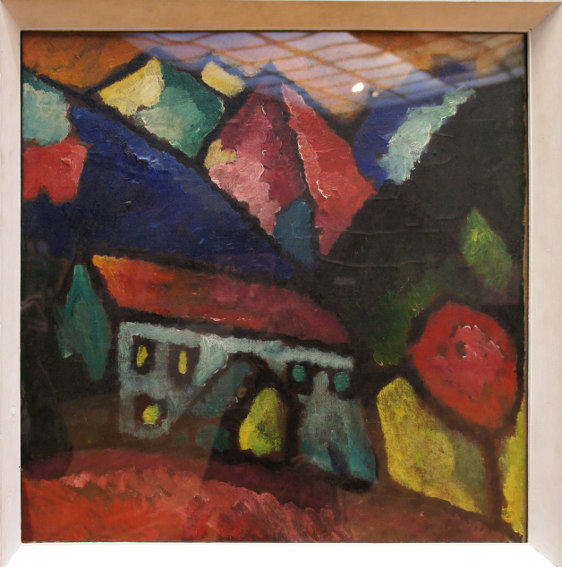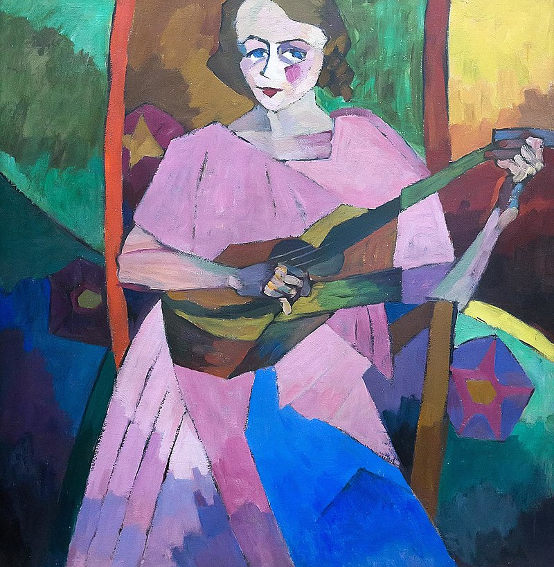
The Knave/Jack of Diamonds and the Russian Avant-Garde
The roots of nearly every Russian avant-garde movement of the 20th Century lie in a short-lived Russian art collective called Бубновый Валет, which had its first exhibition in 1910. In English, the name translates into The Jack (or Knave) of Diamonds, a reference both to the graphic, everyday art style of playing cards and to a colloquial nickname for degenerates. The Jack of Diamonds artists were young, experimental, and rooted in revolutionary beliefs. They rejected the conventional rules of the Russian art academy, which demanded strict adherence to realism, and longed to explore the new art forms being developed outside of Russia. Asserting their belief that their work deserved equal consideration as that of traditional artists from curators and collectors, they mounted their inaugural exhibition at a private house in Moscow in December of 1910. The organizers of the show – described as “the artists Aristarkh Lentulov, Natalia Goncharova and Mikhail Larionov, supported by a young patron, S. A. Lobachev, who has provided the necessary funds to implement their scheme” – released the following statement to coincide with the opening: “Besides the propaganda of the ‘new art’, the organizers pursue another goal – to offer young Russian artists who find it extremely difficult to get accepted for exhibitions under the existing indolence and cliquishness of our artistic spheres, the chance to get onto the main road.” They furthermore explained the “the title Knave of Diamonds” was “a symbol of young enthusiasm and passion, for the knave implies youth and the suit of diamonds represents seething blood.” The enthusiasm of the group spread quickly, and the movement attracted many other young artists. Meanwhile, the art, writings and debates that came out of their meetings and exhibitions spawned even bigger conversations about nationalism versus internationalism, capitalism versus socialism, and esoteric spirituality versus constructive action. The Jack of Diamonds finally disbanded in 1917 — the same year as the outbreak of the Russian Revolution — but their legacy profoundly shaped the development of abstract art, not only in Russia but all over the world.
The Scourge of Sophistication
One of the primary conceits that motivated The Jack of Diamonds artists was the idea that at the turn of the 20th Century Russian art was being eclipsed by European Modernism. The Russian academy considered traditional realistic art to be the epitome of sophistication. In cities like Paris, Vienna and Munich, however, artists were experimenting with fresh, innovative ideas, happily rejecting sophistication in favor of the unknown. Young Russian artists wanted badly to participate in those international conversations, and they also wanted to share with the emergent Modernist world what they believed was unique about Russian culture. They loved Russian folk art traditions, especially as they manifested in everyday mediums such as sign painting, poster printing, and textiles. They hoped to combine those distinctly Russian aesthetic tendencies with the methods being developed by the Fauvists, the Italian Futurists, the German Expressionists, and the Cubists. That synthesis is evident, for example, in the work of Jack of Diamonds co-founder Natalia Goncharova, as her paintings blend the forms and subject matter of the Russian peasantry with the colors, lines and spatial experiments of the European vanguard.

Aristarkh Lentulov - Bellringing. Ivan the Great Bell-Tower, 1915. Oil on canvas.
In service to their belief in internationalism, the first Jack of Diamonds exhibition included works by both Russian and European artists. In addition to Goncharova, the participating Russian artists included Mikhail Larionov, Robert Rafailovich Falk, Alexsey Morgunov, Aristarkh Lentulov, Pyotr Konchalovsky, Ilya Mashkov, Alexey von Jawlensky, and, most notably, Kazimir Malevich, who would go on to found Suprematism. Russian-born Wassily Kandinsky, expatriated in Germany at the time, was also in the show. The European artists were Albert Gleizes, Henri Le Fauconnier, and André Lhote. Reactions from the public to the exhibition made it clear how revolutionary the work seemed to Russian viewers, although it was reported that around 20 paintings sold to wealthy collectors.

Alexei Yawlensky - House in the Mountains, 1912. Oil on canvas.
Wagging The Donkey’s Tail
Most controversial about the first Jack of Diamonds exhibition was the fact that the show blended Russian and European ideas. Not only did the practice threaten members of the Russian art academy, but it even became a source of irritation for some of the founding members of The Jack of Diamonds. Just one year after that first exhibition, Natalia Goncharova, Kazimir Malevich, Mikhail Larionov, and Alexsey Morgunov quit the collective in order to form a rival organization called The Donkey’s Tail. They took their name from a famous trick that had been played on audiences at the 1905 Salon des Indépendants in Paris: a painting allegedly made by a donkey with a brush attached to its tail was hung in the exhibition without letting the public know how it was painted. When no one realized a donkey had painted the work, it was taken as an absurd criticism of the pointlessness of Modernist, and especially abstract, art.

Aristarkh Lentulov - Woman with a Guitar, 1913
The founders of the Donkey’s Tail group embraced the implied allusion their name had to animalistic primitivism. It was a point of pride for them as they wanted to regress from internationalist tendencies to re-discover a primitive form of truly Russian modern art. Their exhibitions included only Russian artists, and out of them arose several iconic Russian movements, including Rayonism, Russian Futurism, and Suprematism. Despite the departure of these four artists, however, The Jack of Diamonds group continued to exhibit and ultimately welcome such prominent artists as Vladimir Tatlin, one of the most famous Russian artists of the 20th Century and founder of the Constructivist Movement, and the French cubist Fernand Léger. Looking back and taking into account all of the artists who participated in this movement, it is ironic that The Jack of Diamonds artists originally felt inferior to their European counterparts. The accomplishments of Malevich, Goncharova, Kandinsky and Tatlin alone are among the most important of any 20th-century artists. They not only helped define the Russian avant-garde, but also influence the development of abstract art all over the world.
Featured image: Wassily Kandinsky - Composition VII, 1913. Oil on canvas.
By Phillip Barcio






